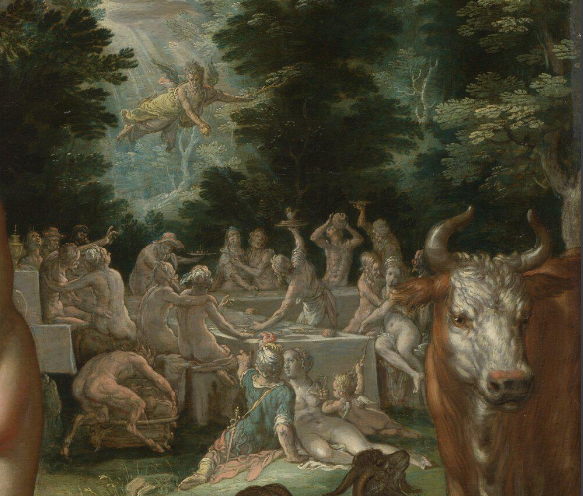The Judgement of Paris
The painting we used for the dress print is The Judgement of Paris from the collection of the National Gallery. Painted by Dutch painter and copperplate engraver Joachim Anthonisz Wtewael in about 1615. The scene depicted in the painting - the Judgement of Paris, provoked one of the most famous wars in mythology, the Trojan War. The story of the Trojan War has many versions, but the first time it was first told was in the Iliad, a work by the Greek poet Homer.
At a party celebrating the marriage of the sea goddess Thetis and the hero Peleus, the goddess of strife and discord, Eris, who was not invited, intruded and threw a golden apple, inscribed 'To the most beautiful goddess', into the party. The apple, like a bomb, destroyed this peaceful and joyful banquet. The three goddesses - Juno, the supreme goddess, Minerva, the goddess of war, and Wenus, the goddess of beauty - began a fierce scramble over it. Paris, a shepherd on Mount Ida, son of King Priam of Ilios, was chosen to intercede. The goddesses each offered Paris a bribe to win. Juno promised unlimited wealth , Minerva promised power,and Venus promised him the most beautiful woman in the world, Helen. Perhaps this is human nature,eventually Paris choosed the most beautiful woman and Venus won in this competition. As a result this conflict within the gods also sparked the Trojan War.
The dark undercurrent beneath the party
In the painting it depicts two completely different scenes in the front and back. In the background, a group of people celebrating the marriage in the forest witnesses the arrival of Eris from the sky and freezes like a white statue, depicting an unusual tension. The foreground depicts the moment when Paris hands the golden apple to Venus in the presence of the gods. The hounds lie peacefully at his feet, while the sheep and cattle also rest quietly. On the right, a nymph wears a crown of flowers and is flirting with a satyr. The overall atmosphere is peaceful and serene.
Yet each of the goddesses is depicted with an interesting expression and pose. on the left side, Juno, with her symbol,the sacred bird peacock riding on a branch, her hands on her hips, looking directly at the audience off-screen, as if she is appealing to everyone who allowed this judgement, that she does not agree. on the right side is Minerva, the goddess of war, wearing a helmet and holding a long spear in her right hand, staring straight at Venus. In the middle of the painting, Venus' body is depicted in a graceful, relaxed tune, with a pearl necklace around his neck, gracefully receiving a golden apple from Paris,as if it was meant to be hers. Poor Paris has not yet known anything, that this dramatic scene, shown by the jealousy and strife of the three goddesses, will soon bring great disaster to himself and to the human world.

The three goddess and Paris

Resting goat

the goddess of strife and discord, Eris and people celebrating the party